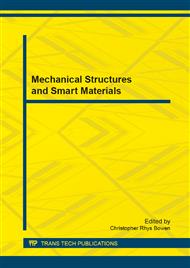p.484
p.488
p.494
p.500
p.504
p.509
p.513
p.517
p.522
Modeling and Simulation of Lower Extremity Exoskeleton
Abstract:
In order to make the paralyzed live on their own and return to the society to the most degree, mechanical exoskeleton technology is tried to applied in the field of auxiliary equipment. First, degrees of freedom and mechanical structure at the each joint of lower extremity exoskeleton was ascertained.Then a three dimensional modeling design for the lower extremity exoskeleton was carried out with SIEMENS NX8.0 and a walking gait on a flat for it was planned on MATLAB basing on inverted pendulum model.Finally the legs model was simulated on ADAMS.The result of the simulation was basically the same as planned gait which can better satisfy the requirement of human walking and can be used as reference for developping the physical prototype of lower extremity exoskeleton.
Info:
Periodical:
Pages:
504-508
Citation:
Online since:
January 2014
Authors:
Price:
Сopyright:
© 2014 Trans Tech Publications Ltd. All Rights Reserved
Share:
Citation:


